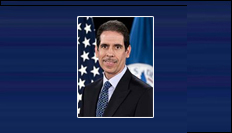SDFM The Business of Defense
-
Dr. Don Berwick Administrator, Centers for Medicare & Medicaid Services Former Congressman Bob Edgar (D-Pa.) President & CEO, Common Cause Susan Turnbull Chair, Maryland Democratic Party Brian Frayer Assistant Chief Shop Steward, AFGE Local 1401 Lance Parcell Shop Steward, AFGE Local 1101 Pete Kovac Shop Steward, AFGE Local 2302
February 17, 2011 -
February 14th and February 16th, 2011 A Conversation on An Open Government Implementation Model: Moving to Increased Public Engagement
February 15, 2011 -
A troubled economy and mobile technology are changing the workplace landscape. Literally.
February 14, 2011 -
FMA joins the show to discuss its National Convention and Management Training Seminar. Find out what you can expect if you attend the event. February 11, 2011
February 11, 2011 -
Rick McCoy President, AFGE TSA Local 777 Don Thomas President, AFGE TSA Local 556 Don Hale AFGE DEFCON Chair Patty Viers AFGE DEFCON Vice Chair Chris Crane President, AFGE Immigration and Customs Enforcement Council 118 Lorenzo Garza Executive Vice President, AFGE Immigration and Customs Enforcement Council 118 Rick Diaz Secretary-Treasurer, AFGE Immigration and Customs Enforcement Council 118
February 10, 2011 -
February 7th and February 9th, 2011 Rafael Borras oversees management of the Department of Homeland Security\'s $56 billion budget, appropriations, expenditure of funds, and accounting, and finance.
February 08, 2011 -
February 9th, 2011 Listen as The Honorable Tom Davis discusses the changes on the Hill and what they could mean for government agencies.
February 07, 2011 -
Scientists at the Department of Energy\'s Ames Research Lab have been able to customize the performance of magnets by strategically replacing key atoms within the material of the magnet. It\'s a process similar to what bioengineers use when they add or delete genes to create synthetic organisms. A group of researchers successfully replaced key atoms in a magnetic compound with atoms of lutetium and lanthanum. Researchers say the discovery may eventually help as scientists search for new exotic substances for use in high-tech products used today and for those in the future. Researchers say - knowing how to identify key atomic positions is similar to understanding the roles specific genes play in an organism\'s DNA sequence - and that knowledge could ultimately lead to materials by design.
February 07, 2011 -
Before the teleworkforce can grab the iPad and go, data storage will need to hit the cloud.
February 07, 2011 -
Senator Tom Harkin (D-Iowa) Congressman Joseph Crowley (D-N.Y.) Former Congresswoman Barbara Kennelly (D-Conn.) President & CEO, National Committee to Preserve Social Security and Medicare Bob Weiner Former Clinton White House Senior Aide Ron Pollack Executive Director, Families USA
February 02, 2011 -
February 8th, 2011 at Noon Today\'s cybersecurity threat continues to evolve into a broad and sophisticated range of adversaries with the skills, resources, patience and motivation to accomplish their goal. Whether it is the theft of intellectual property, state secrets, or the disruption/destruction of critical systems and infrastructure that power our economy and ensure our National security, our Nation is at risk. America\'s cybersecurity against the Advanced Persistent Threat depends on Information Technology as never before. However, it is more than a technology issue. Cybersecurity requires an integrated approach across the full spectrum of people, process and technology to leverage and provide a way of thinking and action to address the issues. The threat to our National economic prosperity and cybersecurity has never been greater and is advancing at a rapid pace in its persistence every day. The goal of this discussion is to explore how the threat has evolved, what the implications are for business leaders, government officials, and our society, and an approach to address this growing challenge.
February 02, 2011 -
Researchers with the National Science Foundation say they\'ve discovered what makes an organutan an orangutan. They\'re not being specious... But rather claim that a new map of the genetic code of endangered orangutans will yield important new conservation tools and insights into evolution. For the first time, scientists have mapped the genome--the genetic code--of orangutans. There are two species of orangutans, defined primarily by their island of origin--either Sumatra, where there about 75-hundred of the creatures, and they\'re considered critically-endangered -- or Borneo where there are about about 50,000. The map of the orangutan genome may support conservation efforts by helping zoos create breeding programs designed to maintain the genetic diversity of captive populations, which can improve a species\' resiliency.
February 02, 2011 -
Social media websites like Facebook and Twitter - and others such as the Department of Homeland Security website - will be used by the Department going forward as part of a new National Terrorism Advisory System. It replaces the old color-coded Terror Alert System. Officials say it will more effectively communicate information about terrorist threats by providing timely, detailed information to the public, government agencies, first responders, airports and other transportation hubs, and the private sector. DHS says - in some cases, alerts will be sent directly to law enforcement or areas of the private sector. Other times, alerts will be issued more broadly to the American people through both official and media channels-including a designated DHS webpage. Alerts will include a clear statement that there is either an \"imminent\" or \"elevated\" threat.
February 02, 2011 -
A type of fungus is being used to produce a hydrocarbon-based fuel by engine experts and biofuels researchers at Sandia National Labs - through funding by the Department of Energy. The biofuels being investigated are produced by a class of fungi called endophytes that live between the walls of plant cells. The cellular material in plant walls can be converted into hydrocarbon compounds that work well as fuels for internal combustion engines. The fungi can turn crystalline cellulosic material directly into fuel-type hydrocarbons without any mechanical breakdown - eliminating the need for the cost-intensive industrial processes required to break down biomass. Through genetic manipulation, the Sandia team hopes to improve yield of the biofuel by tailoring the molecular structure of the hydrocarbons that are produced.
February 02, 2011 -
Satellites - operated by the National Oceanic and Atmospheric Administration - were critical last year in the rescue of hundreds of people from life-threatening situations throughout the U.S. and its surrounding waters. The satellites picked up distress signals from emergency beacons carried by downed pilots, shipwrecked boaters and stranded hikers - relaying information about their location to first responders on the ground. Officials say - of the 295 people saved - 180 people were rescued from water, 43 from aviation incidents, and 72 who were lost on land. NOAA\'s polar-orbiting and geostationary satellites, along with Russia\'s COSPAS spacecraft, are part of the international Search and Rescue Satellite Aided Tracking system. It uses a network of satellites to quickly detect and locate distress signals broadcast by emergency beacons. Alaska had the most people rescued last year with 77, followed by Florida with 37.
February 02, 2011








